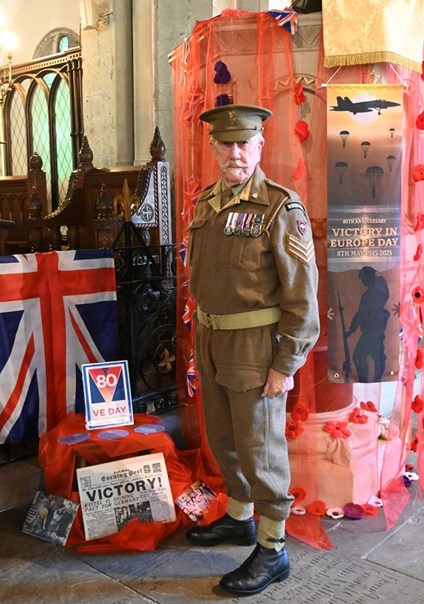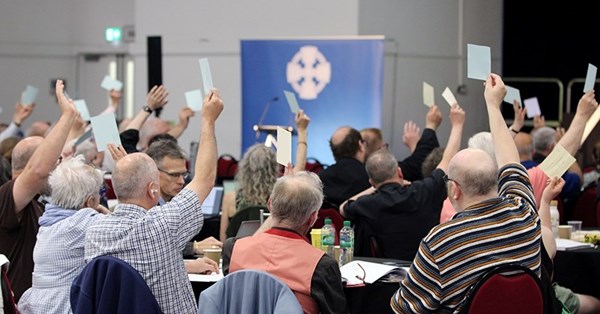VALUING the small and traditional alongside the large and pioneering was a recurrent theme as the Governing Body (GB) of the Church in Wales met in Llandudno last week. “We celebrate the big stories but also the small ones from those small communities who work away at it all, Sunday after Sunday,” the chair of the Representative Body (RB), Professor Medwin Hughes, said.
“But it’s about the people of God sitting together, sharing opportunities that others will come and walk with us. . . I see strong community engagement, discipleship, the beneficial opportunities of creativity, telling the Welsh story and what it means to say, ‘I believe’.”
The RB committed £100 million from capital reserves to a Church Growth Fund intended to encourage innovations for sharing the gospel across Wales. Speaking of its opportunities, the Archdeacon of St Asaph, the Ven. Andrew Grimwood (St Asaph), expressed his happiness about the development. “We are normalising the work of evangelism. That is terribly exciting,” he said.
Projects approved ranged from grants of up to £10,000 — the smallest (£1629), for a Wellbeing Journey Course at three churches in north Cardiff — to those of more than £10,000, of which the largest (£4,685,03) was to mission-hub churches in St Asaph.
The meeting included only one formal debate: a private members’ motion on extending the term of office for elected mission/ministry-area council members. Much centred on feedback from a Diocesan Learning Community event last November, in which clergy and laity considered how the ministry/mission-areas (MA) — launched 12 years ago to replace the parish system — were working in practice.
Survey results were mixed. Comments included: more clergy and more funding needed, simplifying administrative processes, developing a strategic approach to managing church properties, supporting bilingualism, and encouraging innovation. The survey covered areas including outreach evangelism and the involvement of lay people. The picture was found to be best where, the meeting heard, new ministries complemented rather than replaced traditional ministries.
Dr Heather Payne (Llandaff) described the results as “data with soul”. Bob Evans (Monmouth) believed information to be “the important glue that holds us together”. Some practical issues around them surfaced elsewhere: the most heartfelt appeal came at Question Time, when Cathryn Brooker (Monmouth) asked: ‘What is the Church in Wales strategy for closing and closed churches, and who is ultimately responsible for the open churchyards of closed churches?”
 Margam AbbeyMargam Abbey, near Port Talbot, held its Remembrance Service for the 80th anniversary of VE Day on Saturday
Margam AbbeyMargam Abbey, near Port Talbot, held its Remembrance Service for the 80th anniversary of VE Day on Saturday
The Archdeacon of St Davids, the Ven. Paul Mackness (St Davids), replied that there was no national policy of closing churches, and that the closure of a church did not close the churchyard, which remained the responsibility of the Ministry Area, although acknowledged the complexities. “It’s very hard to take that responsibility at ministry-area level. The day will come when people will just say no. Money will have to be found. Rural Wales is going to be covered with declining buildings, and religion in Wales dead.”
The Revd Matt Davies (Monmouth) asked how the Church in Wales could respond theologically, morally, and practically to the inevitable use of AI in everything from email to sermons and prayers, and its ethical use in church communities.
The Archbishop of Wales, the Most Revd Andrew John, reflected: “AI can mimic human tasks but it lacks self-awareness, spiritual conscience and moral responsibility. The Church can set an example by using AI responsibly. . . It must affirm the sacredness of personal dignity.”
A question from Robert Charlton (Swansea & Brecon) focused the GB’s attention on the conviction of Anthony Pierce, a former Bishop of Swansea & Brecon, sentenced to four years for indecent assault on a teenage boy (News, 14 March). Public confidence appeared to demand the earliest possible conclusion of the Church’s disciplinary process, he suggested. He received assurance that the draft report should be completed this month and matters concluded in July.
Safeguarding kept cropping up. In a session after his presidential address, the Archbishop described the emphasis on it as an invitation “not to be some kind of Thought Police association, but to understand it as a golden thread running through all [its] activities”.
Anthony Mullins (Llandaff) urged the Archbishop to “expose and don’t protect” any known perpetrators, to make congregations feel safe. The Revd Ruth Coombs (co-opted) pondered on how the Church might shift its culture “from one of deference”. The Archbishop said that where there might have been constraints ten years ago, questions could now be asked, in the light of “learning and language which previously eluded us”.
Facts and figures on membership were reported as emerging from a membership app being trialled in the CiW. Churches can use it to enter weekly attendance figures for Sunday and midweek services, life events, and other activities such as Café Church and Messy Church, with the aim that resources and support are directed to where they are needed most. Currently, 30 per cent of churches use it.
An invited speaker, Dr Monica Attias of the 70,000-strong Sant’Egidio Community, brought passion and energy to the meeting. The leader of its Humanitarian Corridors programme, she described its members as “ordinary people who choose to view the world from a perspective of those living on the periphery. . . We choose to be not befrienders of the poor but friends of the poor. . . It is not professional assistance but friendship.”
“The world now stresses the word ‘I’, ‘me’, always ‘me’. We live in a time of rapid acceleration in things such as AI, and Christians have to keep as inspiration that the word of God is alive. Nationalism, populism, loneliness, and fear dominate. We are witnesses to the triumph of emotion over reason. The perception of migrants is dominated by fear not reality.”
“Many of our young people come from a very secularised background,” she continued. “Let’s draw them to the poor and they will discover the true essence of Jesus.”
Her words struck a chord with Canon Andrew Lightbown (Monmouth), who ministers in Newport, a town with the highest levels of homelessness in Wales. “The Church in Wales can’t possibly do anything by itself,” he said. “Ecumenism must be befriending others of goodwill. Thank you for reminding us we are a Church that must go to the margins. Our faith demands we stand in solidarity and take risks.”
The GB also welcomed the Principal of St Padarn’s Institute, the Revd Professor Jeremy Duff. “The decision ten years ago to create St Padarn’s now feels visionary,” he said. “We help the Church to live together right across Wales. We do believe that being competent increases confidence. There is more to ministry than preaching a good sermon. Cynicism kills well-being. We don’t do cynicism. We don’t believe that everything good is across the border.”
Canon Mark Clavier (Swansea & Brecon) had experienced ministry in three Provinces. “I’ve never known clergy to be so demoralised as we are now in the West. A lot has to do with challenges we face directly in our ministry. The power of our narrative is in decline. Many of us have never known what it is to minister in a growing Church. I heartily commend the work being done, but [there must be] further attention to how we develop cultures in which clergy can thrive.”
The Bishop of St Davids, the Rt Revd Dorrien Davies, was clear. “Burnout is not an option. We have to be resilient, refreshed, and rested for the tasks of which we are about. The Lord had time to rest. . . That expectation is expected of you also. I appeal to all clergy: be responsible for your time off.”
Bishops had a low profile at this meeting, with the exception of the Bishop of Monmouth, the Rt Revd Cherry Vann, who presented both the Bench of Bishops’ report and the Ministry Development report, which is part of her portfolio.
She acknowledged that it was “a big brief to hold. If we want to see people called into ministry, we need a Church that is more diverse and reflecting the communities in which they are set. That’s the work of us all, not just the clergy. But it is their job to build up and empower the laity.”

















